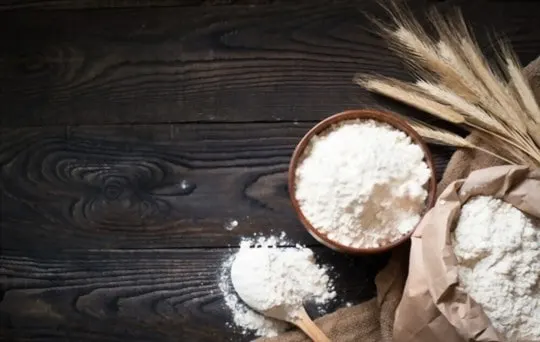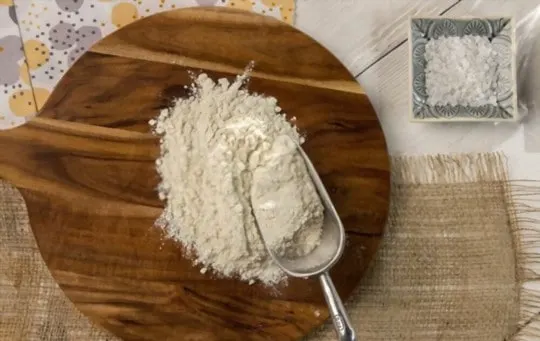Finding a solid Wondra Flour substitute can feel like a kitchen puzzle. No Wondra on the shelf?
No problem. We’ve been there, scrambling to whip up a gravy or a quick-cooking sauce, only to realize our trusty Wondra flour is MIA. It’s not just about thickening.
This flour makes your recipes pop with its unique, super-fine quality that blends seamlessly.
Lucky for us, the world of flours is vast and varied. We’ve rounded up the five best stand-ins that will keep your cooking game strong.
From sauces that hug your spoon just right to batters that crisp to perfection, we’ve got you covered.
What is Wondra Flour?

Wondra Flour is a unique type of flour that is known as an instant or pre-cooked flour.
It’s a product of the well-known company, General Mills, and is sold under their Gold Medal brand.
What sets Wondra Flour apart from regular all-purpose flour is its low-protein content and finely ground texture.
The process of making Wondra Flour involves first cooking the flour, then drying it and finally grinding it to a very fine consistency.
This results in a flour that dissolves almost instantly when mixed with liquids, which is why it’s often referred to as “instant” flour.
One of the main uses for Wondra Flour is in the preparation of sauces and gravies. When using regular flour to make these, it’s common to encounter problems with lumping.
However, because Wondra Flour dissolves so quickly and smoothly, it eliminates this issue, leading to silky smooth sauces and gravies.
In addition to this, Wondra Flour is also popular for baking. Its low-protein content makes it a good choice for recipes where a light, delicate texture is desired.
For example, it’s often used in recipes for pie crusts, cakes, pastries, and other baked goods.
Despite the unique properties and benefits of Wondra Flour, it’s not as commonly found in household kitchens as regular flour.
This is partly because it’s not always readily available in all grocery stores and partly because many people are simply not aware of what it is or how to use it.
So, whether you’re a seasoned home cook looking to experiment with new ingredients or a beginner hoping to up your sauce-making game, Wondra Flour could be just the ingredient you need.
The 5 Best Substitutes for Wondra Flour
There are a few options for those searching for a Wondra flour substitute.
At the same time, they are not an exact match; each of these substitutes will work well in most recipes.
1 – Rice Flour

Rice flour is a type of flour made from finely milled rice.
It’s a versatile ingredient that can be used in various recipes, from cakes and cookies to savory dishes.
While it’s not as commonly available as other types of flour, it’s relatively easy to find in health food stores or online.
Rice flour can be used as a replacement for wheat flour in many recipes, and it’s also gluten-free and appropriate for those with celiac disease or gluten intolerance.
In addition, rice flour is a good choice for people with diabetes or who are watching their blood sugar levels, as it has a lower glycemic index than wheat flour.
The main downside of rice flour is that it doesn’t have the same protein content as wheat flour, so it may not be suitable for all recipes.
2 – Cassava Flour

While cassava flour is not as nutrient-dense as other flours, it does have a few unique benefits that make it worth trying in your baking recipes.
Cassava flour is a gluten-free, grain-free flour made from the root of the cassava plant.
It has a light, fluffy texture and a neutral taste, making it a versatile ingredient for sweet and savory dishes.
Cassava flour is also high in fiber and resistant starch, improving gut health.
Additionally, cassava flour is a good source of vitamins and minerals, including zinc, magnesium, and vitamin B6.
3 – Tapioca Flour

Tapioca flour is a unique ingredient that can be used in various recipes.
It is made from the cassava root, which is native to South America.
The cassava root is peeled and grated, and the pulp is strained to create a fine flour.
Tapioca flour has a mild flavor and a slightly sweet taste.
It is also gluten-free and high in carbohydrates.
One of the most popular uses for tapioca flour is in making Brazilian pão de queijo (cheese bread).
This bread is traditionally made with yucca flour, but tapioca flour can also be used.
Tapioca flour can also thicken soups and sauces or as a coating for fried foods.
It is available in most supermarkets and can also be found online.
4 – Mix Cornstarch and All-purpose Flour

One of the most versatile ingredients in any kitchen in flour.
All-purpose flour can be used for baking, thickening sauces, and even dusting surfaces for rolling out dough.
However, there are times when a recipe calls for something a little bit different.
That’s where cornstarch comes in.
Cornstarch is a fine powder made from the starch of corn kernels.
It’s often used as a thickener for soups and sauces or as a coating for fried foods.
Combined with all-purpose flour, it creates a blend that can be used virtually any purpose.
The cornstarch helps to lighten the flour and gives it a finer texture, making it ideal for baked goods.
It also has a neutral flavor, so it won’t alter the taste of your recipes.
Whether you’re looking to add some extra body to your pancakes or create a perfect pie crust, a mix of cornstarch and all-purpose flour is the way to go.
5 – Whole Wheat Flour

Whole wheat flour can be used in a variety of recipes, from bread and pizza dough to cookies and cakes.
Whole wheat flour is made from the entire wheat grain, including the bran and germ.
This results in flour that is higher in fiber and nutrients than refined wheat flour.
When baking with whole wheat flour, it is important to note that it absorbs more liquid than refined flour, so you may need to add additional liquid to your recipe.
Whole wheat flour is also heavier than refined flour, so your baked goods may have a denser texture.
The darker color of whole wheat flour can also affect the color of your final product.
Conclusion
In conclusion, there are many substitutes for Wondra flour that can be used in recipes.
Each of these substitutes has its own unique properties that make them ideal for different types of recipes.
When choosing a substitute for Wondra flour, it is important to consider the desired outcome of the recipe.
Each of the substitutes listed above has its own strengths and weaknesses.
Use the information in this article to choose the best substitute for Wondra flour based on your needs.

The 5 Best Substitutes for Wondra Flour
Ingredients
- Rice Flour
- Cassava Flour
- Tapioca Flour
- Mix Cornstarch and All-purpose Flour
- Whole Wheat Flour
Instructions
- Pick your favorite substitute from the list above.
- Follow cooking directions for your selected substitute with the proper ratio of ingredients.

Andrew Gray is a seasoned food writer and blogger with a wealth of experience in the restaurant and catering industries. With a passion for all things delicious, Andrew has honed his culinary expertise through his work as a personal chef and caterer.
His love for food led him to venture into food writing, where he has contributed to various online publications, sharing his knowledge and insights on the culinary world. As the proud owner of AmericasRestaurant.com, Andrew covers a wide range of topics, including recipes, restaurant reviews, product recommendations, and culinary tips.
Through his website, he aims to inspire and educate fellow food enthusiasts, offering a comprehensive resource for all things food-related.

Leave a comment